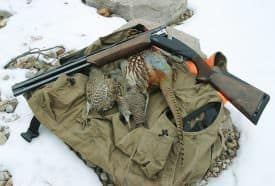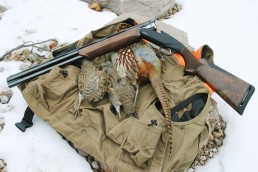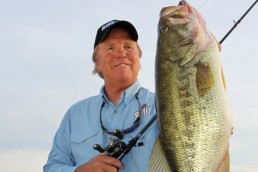Field-testing a New O/U Shotgun Design
SHARE THIS POST
In the gun business, never say never. As a direct result of some major design changes from Benelli, the company that for years has been the autoloading and pump gun manufacture associate with both sporting- and military-based shotguns, has come out with a stack barrel that is completely off the charts in terms of innovative design features.
The parent company Beretta is and has always been the go-to company when the subject turns to side by side or stack barrel shotguns. Well folks, I guess time marches on, and as such, the tables have turned with the release of the new 828U over and under 12 gauge by Benelli USA. This design, according to some of my Russian associates on Facebook, is not completely new. While I can’t verify any of this information, I was told that the basic breech design used on the new Benelli 828 may be from a 1906 patent by a guy named Jagers. The Russian writers were at Shot Show last year, and because the gun was the “top billing” at that event, they got a good look at her and could well have test-fired a sample of the gun during the press relations day.

You could say with relative accuracy that for the most part, Benelli’s smooth bore designs have been spot on the track when it comes to successful ventures. Now, enter the new Benelli 828U: During Shot Show 2015, I was introduced to the gun, both on the writer-event day trap range and later in the show itself, via that massive Benelli shotgun display. The gun was the sporting shotgun of the show without question, and as such, pulled in a large group of onlookers and writers who wanted a piece of this new Benelli project.
So what’s the big deal regarding the 828?
First of all, every part that is not subjected to PSI or kinetic energy stress is made of lightweight material carbon fiber, including special ordinance-grade aluminum, lightweight steel and possible polymers. There is so much in the way of material advancement in this shotgun that it likely takes an expert to find it all. The end result of all this blending of material is a 7 1/4-pound shotgun that points like lighting, is a dream to carry and won’t result in shooting stress even when sending lots of rounds downrange during a given day. I know as I have field-tested the system over a month of upland and light waterfowl hunting here in South Dakota.
In the action department, first off, the primary receiver lugs that hinge the barrel are very small and are only used to support the tubes. Gone is the need to build massive trunnions that take recoil pounding and in time wear out. The release latch being off-center is no longer an issue, as that whole set of parts are not involved in recoil shock and gradual terminal metal fatigue. What the receiver/action of the hanged barrels will do is the following and I am doing my best, as I am not an engineer or gunsmith: When rounds are chambered, several events take place. First of all, the rear of the receiver breech retains no conventional block, but rather a floating spring-mounted breechblock plate made of hard steel and heavy chrome. This breechblock takes the impact of kinetic energy and sets back forces when a round is fired. This floating block in-gauges corresponding machined surfaces on the barrels monobloc, and becomes a solid locking unit for the receiver system. Now, material that’s more lightweight can be used for the bulk of the receiver because it is not directly effective by recoil or kinetic stresses. I must admit that I didn’t understand the system until I actually functioned the shotgun and observed the locking system in action. In talking with the staff at Cabela’s gun library in Rapid City, S.D., I was informed that indeed there was some skepticism among the potential 828 buyers, but to date none have been returned with any problems.
The firing pins are mounted with springs that retract them as the action closes, making use of a solid secondary breech rear wall. The ejectors are automatic and will hold the unfired shotshells in place, as in most other stack barrel designs. The safety is unique in that it is a one-piece button that is a nice size for a gloved hand in the field. Inside, the button is a “second” one that moves right or left to designate the correct barrel to be fired. This system is solid with no loose flop that can often result in a centered selector that produces a miss-fire at best.
The metal-to-wood fit is flatly outstanding in every respect. With marked double A-grade, Benelli is not kidding at about that. The wood is Turkish walnut and some of the nicest I have seen in a very long time. Looking over three different guns, I would have a very hard time selecting a better one.
Field use consisted of hunting grouse on the open prairie and jumping stock dams for local ducks. Both events were positive and illustrated that this is a true carry-field gun versus makeover clays gun or an
overweight duck cannon. With a well-centered weight on my test 26-inch barrel gun, I found it mounted very fast and was easy to stay ahead of rising, sharp tail grouse. In terms of a day of walking pheasants, this stack barreled gun will fit the bill nicely. And due to a long ditch chicken season here in South Dakota, I intend to get the 828 out and dust a few roosters as well.
Being lightweight, recoil could be a consideration that requires attention. During clays testing, I did shoot some heavyweight upland and waterfowl loads, which did return some stiff recoil. However, due to the very unique in-butt stock recoil system (Progressive Comfort), recoil is damped greatly.
Are you enjoying this post?
You can be among the first to get the latest info on where to go, what to use and how to use it!
Exactly how much? I did not have any gauging system, but I can say that by way of a lightweight shooting vest and hoodie 12 rounds of 13/8 ounce, and 3-inch duck fodder, it left no mark on my shoulder or even give any sensation of excessive stain. I would say that in the event the shooter were going to stay with the gun for a long time in any given day shooting clays, there could well be some fatigue and strain observed to set in. This is a field gun designed for some shooting and a whole lot of carrying.
With custom-grade Cryo (cold metal treatment), the smooth-as-glass twin pipes coupled with Benelli long chokes, deliver very solid patterns that run the full range of standard constrictions. Pattern work, due to the onset of a Dakota winter, on the outdoor range was limited. But dead birds that were checked for a pellet count indicated a solid functional payload delivery system to be sure. Winchesters’ new number 7 1/2, and 1-ounce steel shot at 1450 was a “go” to load on an early-morning, two-track, random-jumped grouse. The loads, even though light in payload weight, hit hard and did far more than act as a good clays’ load for those shooters wanting to get an edge of a high-velocity terminal target effect with non-toxic shot.
Shooting Federal Black Cloud in 3 inches, and at 1 1/8 ounces, and with number 2’s with a muzzle velocity of 1635 on waterfowl, and pushing up to the Benelli full-choke, crushed gadwall at a strong 55 to 65 yards on two occasions. Jump shooting or gunning over a stock dam requires range extension due to the fact that sure- as-can-be ducks will land at the far end of the pool instead of your decoy spread much of the time. While primarily not a wet bird gun, the 828 stepped up to the task and got the job done.
Taking into account the carbon fiber removable one-screw rib, butt stock comb attachment that is adjustable and removable, a selection of included spacers at the leading edge of the stocks grip and a drop trigger unit that can be adjusted, your talking about an almost-full, custom shotgun right out of the box.
In terms of anything negative regarding the 828, I would have to say that the finish on the black receiver model AA grade worries me just a bit. I have tested a number of aluminum receiver shotguns over the years, and if I go afield and use the shotgun as a game-harvesting system, it tends to take on the look of a 5-year-old shotgun after two weeks. Nothing I have found can fix slight nicks and lost blue-black in this area of the shotgun. Because it is right where the hand meets the receiver, it will see some general ware, without question.
I will say I have ordered one of these stack barrels, as I do believe it is a new age in the art of gun making. However, the model I have put my hard-earned money down on is the nickel receiver AA grade, which offers totally due to the fact that this option will hold up better when marching through high corn fields, a willow swamp or farmland. As to the remainder of the gun, both choices are exactly the same regarding the guts of the systems.
Again, as to Jagers getting the patent, I can’t confirm or deny it. But about that time there were number of very unique action types cropping up that faded away down the line as such. I have a side by side built by Husquavarna—the gun is a design that uses the forend, built-in receiver latch (all metal) to slide right and open the action pins or contact lugs. I have also seen another designs of the time that moved the whole barrel receiver assembly to the right when activating a lever built into the underside of the receiver/forend. Regardless of its time and origin, this is one sweet design for the 828 in terms of keeping the over and under up and functioning and maintaining reduced weight in the process.
There is very little doubt that the 828U will surface in the future as a 20-gauge shotgun and likely as a camo-dressed duck gun as well. Remember these are the gun builders that came up with the Super Black Eagle. With this being the case, I would not consider anything in the area of varied model offerings to be out of question.
L.P. Brezny has worked in research and development across the shooting industry for 37 years. He has developed and marketed systems for 12 gauges, designed ammunition for Winchester and Federal Cartridge, designed separator quiet slugs, shotshells and one-choke do-it-all systems. Brezny was the first ballistics writer to measure shotgun pellets in flight to ranges as great as 100 yards. He has published three books on shooting (Gun Digest Books), and is completing a fourth on long-range rifle applications. He has published hundreds of articles on sending rounds downrange.
Did you enjoy this post?
You can be among the first to get the latest info on where to go, what to use and how to use it!
L.P. Brezny
Writing on outdoor subjects for over 40 years, L.P. Brezny has written four books on shotgun and rifle (ballistics and performance). He’s an expert at smoothbore, and high-power, ultra-long-range shooting. He’s a specialist, producing reviews covering general products used in the outdoors industry.

